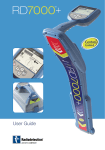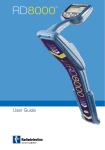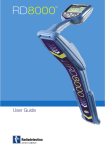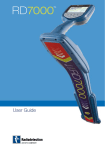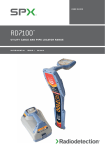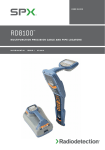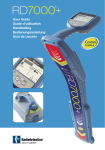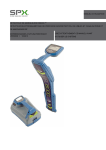Download Radiodetection RD7000 User guide
Transcript
™ User Guide Preface About this guide This guide provides basic operating instructions for the RD7000 receiver and transmitter. Please read this guide in its entirety before attempting to operate the RD7000. This guide is intended as a portable reference only. For detailed instructions, please refer to the RD7000 operation manual, which is available for download from www.radiodetection.com. To download the manual go to the Library section, which is accessible via the menu; next go to Cable and Pipe Locators and then select User Manuals and click the RD7000 Operation Manual link. The online User Manual library also contains links to the SurveyCERT™ and eCAL™ manuals. Copyright statement This user guide is Copyright 2008 Radiodetection Ltd. Radiodetection is a subsidiary of SPX Corporation, all rights reserved. Trademarks RD7000, RD4000, flexitrax and eCAL are trademarks of Radiodetection Ltd. Important notices When reporting any problems to your Radiodetection Dealer or Supplier it is important to quote the unit serial number and the purchase date. WARNING! This equipment is NOT approved for use in areas where hazardous gases may be present. WARNING! When ���������������������������� using the transmitter, switch ����������������������������������� off the unit and disconnect cables before removing the battery pack. Reduce audio level before using the earpiece. Batteries should be disposed of in accordance with your company’s work practice, and/ or any relevant laws or guidelines in your country. This instrument, or family of instruments, will not be permanently damaged by reasonable electrostatic discharge and has been tested in accordance with IEC 801-2. However, in extreme cases temporary malfunction may occur. If this happens, switch off, wait and switch on again. If the instrument still malfunctions, disconnect the batteries for five seconds and then reinstall and switch the unit on. WARNING! The RD7000 will detect almost all buried conductors but there are some objects that do not radiate any detectable signal. The RD7000, or any other electromagnetic locator, cannot detect these objects so proceed with caution. There are also some live cables which the RD7000 will not be able to detect in Power mode. The RD7000 does not indicate whether a signal is from a single cable or from several in close proximity. FCC and Industry Canada statements This device complies with part 15 of the FCC Rules. Operation is subject to the following conditions: (1) This device may not cause harmful interference, and (2) this device must accept any interference received, including interference that may cause undesired operation. Changes or modifications not expressly approved by the party responsible for compliance could void the user’s authority to operate the equipment. To comply with the FCC RD explore compliance requirements, this device and its antenna must not be colocated or operated in conjunction with any other antenna or transmitter. Training Radiodetection provides training services for most Radiodetection products. Our qualified instructors will train equipment operators or other personnel at your preferred location or at Radiodetection headquarters. For more information go to www.radiodetection.com or contact your local Radiodetection representative. RD7000 receiver 2 1 3 4 5 8 6 7 8 15 14 10 11 9 12 13 14 16 17 23 24 18 19 20 21 22 Receiver features 1. Keypad. 2. LCD. 3. Battery compartment. 4. Accessory slot. 5. Headphone jack. Receiver keypad 6. Power key: Switches the unit on and off. Opens the receiver menu. 7. ƒ key: Selects frequency. Menu navigation key. 8. Up and down arrows: Adjusts the signal gain. Scrolls through the menu options. 9. Antenna key: Toggles peak and null (PL and TL only) modes. Open submenu. Displays depth or current. Receiver screen icons 10. Indicates the signal strength and peak marker. 11. Signal strength: Numeric indication of signal strength. 12. Peak arrows: Indicates the location of the line relative to the receiver. 13. Battery icon: Indicates the battery level. 14. Volume icon: Displays the volume level. 15. Fault-Find arrows (PL and TL only) 16. Radio Mode: Indicates when Radio Mode is active. 17. Power Mode: Indicates when Power Mode is active. 18. Accessory indicator: Indicates when an accessory is connected. 19. A-Frame icon: Indicates when the A-Frame is connected. 20. Operating mode indicator. 21. Null / Peak / Single Mode icon: Indicates antenna selection. 22. Sonde icon: Indicates that the signal source is from a sonde. 23. Line icon: Indicates that the signal source is from a line. 24. Current / depth indicator. Tx1, Tx3 and Tx10 transmitters 1 2 3 4 6 5 7 10 11 6 12 17 18 8 19 13 14 15 16 9 20 Transmitter features 1. Keypad. 2. LCD. 3. Removable accessory tray. Transmitter keypad 4. Power key: Switches the unit on and off. Open the transmitter menu. 5. ƒ key: Selects frequency. Menu navigation key. 6. Up and down arrows: Adjusts the output signal. Scrolls through the menu options. 7. Measure key: Toggles measurement display between volts, current and impedance. Note: displayed measurements are based on the currently selected mode or the attached accessory, if applicable. Opens a submenu. Transmitter screen icons 8. Battery icon: Indicates the battery level. 9. Alphanumeric description of selected operation mode. 10. Standby icon: Appears when the transmitter is in Standby Mode. 11. Output level: Displays transmitter output power. 12. Clamp icon: Indicates when a clamp is connected. 13. DC icon: Appears when the transmitter is powered from a DC source. 14. Induction indicator: Appears when the transmitter is in Induction Mode. 15. A-Frame: Indicates when the transmitter is in Fault-Find Mode. 16. CD Mode indicator: Indicates that the transmitter is in Current Direction Mode. 17. Voltage warning indicator: Indicates that the transmitter is outputting potentially hazardous voltage levels. 18. Volume icon: Displays the volume level. 19. Pairing icon (Tx 3B and Tx10B only): Appears when the transmitter and RD8000 receiver are connected via iLOC™ 20. Bluetooth® icon (Tx 3B and Tx10B only). Indicates status of Bluetooth® connection Flashing icon means pairing is in progress. Before you begin IMPORTANT! Please read this section before you attempt to operate the RD7000! Starting the system The receiver and transmitter are battery powered. Install good quality D-cell NiMH or Alkaline batteries into the receiver and transmitter battery compartments. Alternatively, you can power the transmitter from a mains or vehicle power source using a Radiodetection supplied adapter. To switch the receiver or the transmitter on, press and hold the keypad Power Key for two seconds. NOTE: Once the system is switched on, pressing the Power Key momentarily will activate the receiver or transmitter menu. System setup It is important that you set up the system according to your personal preferences and operating requirements before you conduct your first survey. You can set the system up using the RD7000 menu as described below. Before changing settings, ensure the receiver or transmitter is switched on by pressing the keypad Power Key for two seconds. Power / mains frequency Select the correct frequency (50 or 60Hz) for your country or region’s national power supply. To change power frequency on the transmitter and the receiver: 1. Press the Power Key momentarily to enter the menu, 2. Scroll to the POWER option using the arrow keys, 3. Press the Right arrow ( submenu, 4. Scroll up or down using the up and down arrows to select the correct frequency, 5. Press the Left arrow (ƒ on the transmitter) to accept your selection and return to the main menu, 6. Press the Power Key to return to the main operation screen. on the transmitter) key to enter the POWER Language To select your preferred menu language: 1. Press the Power Key on the receiver momentarily to enter the menu, 2. Scroll to the LANG option using the arrow keys, 3. Press the Right arrow key ( 4. Scroll up or down using the up and down arrows to select your preferred language, on the transmitter) to enter the LANG submenu, 5. Press the Left arrow (ƒ on the transmitter) to accept your selection and return to the main menu. 6. Press the Power Key to return to the main operation screen. Units The RD7000 allows you to work in Metric or Imperial (US customary) units. To select your preferred units of measurements: 1. Press the Power Key momentarily to enter the menu, 2. Scroll to the UNIT option using the arrow keys, 3. Press the Right arrow key to enter the UNIT submenu, 4. Scroll up or down using the up and down arrows to select Metric or Imperial units, 5. Press the Left arrow to accept your selection and return to the main menu. 6. Press the Power Key to return to the main operation screen. Battery The RD7000 receiver and transmitter support both NiMH or ALK batteries. It is important that you set the system to match the currently installed battery type to ensure optimal performance and correct battery level indication. To set your battery type: 1. Press the Power Key momentarily to enter the menu, 2. Scroll to the BATT option using the arrow keys, 3. Press the Right arrow key ( 4. Scroll up or down to select the correct battery type, 5. Press the Left arrow (ƒ on the transmitter) to accept your selection and return to the main menu. 6. Press the Power Key to return to the main operation screen. on the transmitter) to enter the BATT submenu, The RD7000 is now ready to use. Shutting down To switch the receiver or the transmitter off, press and hold the keypad Power Key for two seconds. Using the menu The RD7000 receiver and transmitter menus allow you to select or change system options. Once entered, the menu is navigated using the arrow keys. Navigation is consistent on both the transmitter and the receiver. When in the menu, most on-screen icons will temporarily disappear and the menu options will appear in the bottom left-hand corner of the LCD. Note that when browsing the receiver menu, the ƒ and Antenna keys act as Left and Right arrows. When browsing the transmitter menu the ƒ and keys act as Left and Right arrows. The Right arrow enters a submenu and the Left arrow returns to the previous menu. Note: When you select an option and press the Left arrow, the option will be enabled automatically. To navigate the receiver menu: 1. First power up the receiver. 2. Press the Power button to enter the menu. 3. Use the Up and Down arrows to scroll through the menu options. 4. Press the Right arrow to enter the option’s submenu. 5. Press the Left arrow to return to the previous level. 6. Press the Power Key to return to the main operation screen. Receiver menu options • VOL: Adjusts the speaker volume from 0 (mute) to 3 (loudest). • UNIT: Choose metric or imperial units. • LANG: Selects your preferred system language. • POWER: Sets national power frequency: 50 or 60Hz. • FREQ: Enable or disable individual frequencies. • ALERT: Enable or disable StrikeAlert™. • BATT: Sets battery type. NiMH or ALK. To navigate the transmitter menu: 1. First power up the transmitter. 2. Press the Power button to enter the menu. 3. Use the Up and Down arrows to scroll through the menu options. 4. Press the Right arrow to enter the option’s submenu. 5. Press the Left arrow to return to the previous level or exit the menu. 6. Press the Power Key to return to the main operation screen. Transmitter menu options • VOL: Adjusts the speaker volume from 0 (mute) to 3 (loudest). • BT: Enable, disable or pair Bluetooth® connections (Tx 3B and Tx10B only). • MAX V: Sets the output voltage. • MODEL: Specifies the model of your RD7000 receiver. • MAX P: Select a specifix maximum output wattage. • BATT: Sets battery type. NiMH or ALK. • OPT F: Enable or disable SideStepauto™. • LANG: Selects the transmitter system language. • BOOST: Boosts transmitter output for a specified period of time (in minutes). • FREQ: Enable or disable individual frequencies. Using accessories Both the transmitter and receiver are compatible with a wide range of accessories, including all RD4000 accessories. Use clamps to help apply a signal to pipeline or live wire. Use an A-Frame to provide the RD7000 receiver with advanced fault-finding capabilities. When an accessory is connected, the receiver or transmitter will instantly recognize it and will enable the mode appropriate to the accessory. For example, attaching an A-Frame (TL or PL only) to the RD7000 receiver will automatically switch the receiver to fault-find mode and limit the number of available frequencies to those that are compatible with the A-Frame. The LCD will also display an icon of the accessory and will remove any non-essential icons from the screen. Locating pipes and cables Passive Frequencies Passive frequency detection takes advantage of signals that are already present on buried metallic conductors. The RD7000 supports two types of passive frequencies: power and radio signals. You can detect these frequencies without the aid of the transmitter. Active Frequencies Active frequencies are applied direct to the pipe or cable using the transmitter. The transmitter can apply a signal using two methods: induction and direct connection. Induction The transmitter is placed on the ground over or near the survey area. You select the appropriate frequency. The transmitter will then induce the signal indiscriminately to any nearby metallic conductor. In induction mode, using higher frequencies is generally recommended as they are inducted easier onto nearby conductors. Direct connection In direct connection, you connect the transmitter directly to the pipe or cable you wish to survey. The transmitter will then apply a discreet signal to the line, which you can locate using the receiver. This method provides the best signal on an individual line and enables the use of lower frequencies, which can be traced for longer distances. Connecting the transmitter to a pipe or line requires the use of a direct connection lead or clamp and a ground stake to complete the circuit. WARNING! Direct connection to live wires is POTENTIALLY LETHAL. Direct connections should be attempted by fully qualified personnel only! Signal clamps A signal clamp can apply a signal to a live line without breaking the connection. Signal clamps are connected to the transmitter’s accessory socket. Radiodetection supplies a range of signal clamps to suit most applications. Note that the RD7000 is fully compatible with the RD4000 range of signal clamps. Stethoscopes At times, it may not be possible to use a clamp around a cable because of congestion or inaccessibility. A stethoscope antenna should be used in place of a clamp to identify cables. Radiodetection supplies a range of stethoscopes to suit most applications. As with signal clamps RD7000 is fully compatible with the R4000 range of stethoscopes. To use a stethoscope, connect it to the receiver’s accessory socket. The receiver will automatically detect the device and filter out location modes that are irrelevant. Locating sondes Sondes are self-contained, battery powered transmitters that are useful for tracking non-metallic pipes. The RD7000 PL, DL and TL can detect a range of sonde frequencies, including those transmitted by flexisondes and the P350 flexitrax™ crawler (visit www.radiodetection.com for more information on other Radiodetection products). To locate a sonde 1. Set up the sonde according to the sonde’s user documentation. Make sure the sonde is sufficiently powered for the duration of the survey; note the sonde’s operating frequency, 2. Deploy the sonde into the pipe or duct as required, 3. On the receiver, select the sonde frequency by pressing the ƒ key until the desired frequency is displayed on the LCD and the sonde icon is visible, 4. Set the gain to approximately 60-80%, A sonde radiates a peak field from the center of its axis with ghost signals at each side of the peak. Move the receiver to one side and then along the axis of the sonde forwards and backwards to detect the ghost signals. Radiodetection recommends locating the ghost signals as finding them confirms the position of the main peak. To lose the ghost signals, reduce the sensitivity of the receiver; this should leave only the main peak signal detectable. With the receiver sensitivity set as desired, propel the sonde along three or four meters and stop. Place the receiver over the estimated position of the sonde and: 1. Hold the receiver vertically with the blade in line with the sonde, 2. Move the receiver backwards and forwards with the blade’s orientation parallel to the sonde, 3. Stop when the bar graph indicates a clear peak, 4. Rotate the receiver until the blade’s orientation is perpendicular to the sonde, stop when the bar graph indicates a clear peak, 5. Move the receiver from side to side until the bar graph indicates a clear peak. When the receiver locates a peak signal, it will automatically calculate the depth of the sonde. Observe the depth reading while moving the receiver from side to side; the lowest reading will be the correct location. Repeat each step in smaller increments with the receiver blade resting on or near the ground. The receiver should now be directly above the sonde with the blade in line with the sonde; mark this position. Propel the sonde a further three to four meters along the pipe to pinpoint its location. Mark the location as required. Repeat the procedure along the route at similar intervals. Note, while tracking the sonde, altering the receiver’s sensitivity is not required unless the pipe’s depth, or the distance between receiver and sonde changes. Fault-finding The RD7000 TL and PL have the ability to detect cable faults accurately using an accessory A-Frame. Fault-finding works by detecting signal to ground bleeding caused by damaged cable sheaths. For a detailed guide to fault-finding, please refer to the RD7000 operation manual. Service and Maintenance Use eCAL™ to determine if your RD7000 receiver is still within its original factory calibration settings. For more information visit www.radiodetection.com The receiver and transmitter are designed so that they do not require regular calibration. However, as with all safety equipment, it is recommended that they are serviced at least once a year either at Radiodetection or an approved repair center. Radiodetection products, including this user guide, are under continuous development and are subject to change without notice. Go to www.radiodetection.com or contact your local Radiodetection representative for the latest information regarding the RD7000 or any Radiodetection product. Warranty Subject to the conditions set out herein, Radiodetection Limited expressly and exclusively provides the following warranty to original end user buyers of Radiodetection products. Radiodetection products includes Radiodetection, Pearpoint, Telespec, Bicotest, Riser Bond, Dielectric, Mark Products and Warren G-V brands. Radiodetection hereby warrants that its products shall be free from defects in material and workmanship for one year starting from point of sale to end customer. Extensions of this warranty period are available where the same terms and conditions apply. Product families include: • Cable & Pipeline Location • Trenchless • Pipeline Integrity • Pipeline Video Inspection • Ground Penetrating Radar • Water Leak Detectors • Cable Test • Cable Dryers To register for an extended warranty (3 years) go to: www.radiodetection.com/support/warranty Statement of warranty conditions The sole and exclusive warranty for any Radiodetection product found to be defective is repair or replacement of the defective product at Radiodetection’s sole discretion. Repaired parts or replacement products will be provided by Radiodetection on an exchange basis and will be either new or refurbished to be functionally equivalent to new. In the event this exclusive remedy is deemed to have failed of its essential purpose, Radiodetection’s liability shall not exceed the purchase price of the Radiodetection product. In no event will Radiodetection be liable for any direct, indirect, special, incidental, consequential or punitive damages (including lost profit) whether based on warranty, contract, tort or any other legal theory. Warranty services will be provided only with the original invoice or sales receipt (indicating the date of purchase, model name and dealer’s name) within the warranty period. This warranty covers only the hardware components of the Radiodetection product. Data storage media or accessories must be removed prior to submission of the product for warranty service. Radiodetection will not be responsible for loss or erasure of data storage media or accessories. Radiodetection is not responsible for transportation costs and risks associated with transportation of the product. The existence of a defect shall be determined by Radiodetection in accordance with procedures established by Radiodetection. This warranty is in lieu of any other warranty, express or implied, including any implied warranty of merchantability or fitness for a particular purpose. condition and standard other than prescribed by RD This warranty does not cover: a. periodic maintenance and repair or parts replacement due to wear and tear b. consumables (components that are expected to require periodic replacement during the lifetime of a product such as non-rechargeable batteries, bulbs, etc.) c. damage or defects caused by use, operation or treatment of the product inconsistent with its intended use d. damage or changes to the product as a result of: i. misuse, including: - treatment resulting in physical, cosmetic or surface damage or changes to the product or damage to liquid crystal displays ii. failure to install or use the product for its normal purpose or in accordance with RD instructions on installation or use iii. failure to maintain the product in accordance with RD instructions on proper maintenance iv. installation or use of the product in a manner inconsistent with the technical or safety laws or standards in the country where it is installed or used v. virus infections or use of the product with software not provided with the product or incorrectly installed software vi. the condition of or defects in systems with which the product is used or incorporated except other ‘RD products’ designed to be used with the product vii. use of the product with accessories, peripheral equipment and other products of a type, viii. repair or attempted repair by persons who are not RD warranted and certified repair houses ix. adjustments or adaptations without RD’s prior written consent, including: x. i. upgrading the product beyond specifications or features described in the instruction manual, or ii. modifications to the product to conform it to national or local technical or safety standards in countries other than those for which the product was specifically designed and manufactured neglect e.g. opening of cases where there are no user replaceable parts xi. accidents, fire, liquids, chemicals, other substances, flooding, vibrations, excessive heat, improper ventilation, power surges, excess or incorrect supply or input voltage, radiation, electrostatic discharges including lighting, other external forces and impacts. Notes Radiodetection Ltd. Western Drive, Bristol BS14 0AF, UK Tel: +44 (0) 117 976 7776 Fax: +44 (0) 117 976 7775 Email: [email protected] Radiodetection 154 Portland Road, Bridgton, ME 04009, USA Tel: +1 (207) 647 9495 Toll Free: +1 (877) 247 3797 Fax: +1 (207) 647 9496 Email: [email protected] www.radiodetection.com Radiodetection products are under continuous development and are subject to change, we reserve the right to alter or amend any published specification without notice. Copyright 2008 Radiodetection Limited. All rights reserved. Radiodetection Ltd. is a subsidiary of SPX. 90/UG078ENG/02


















